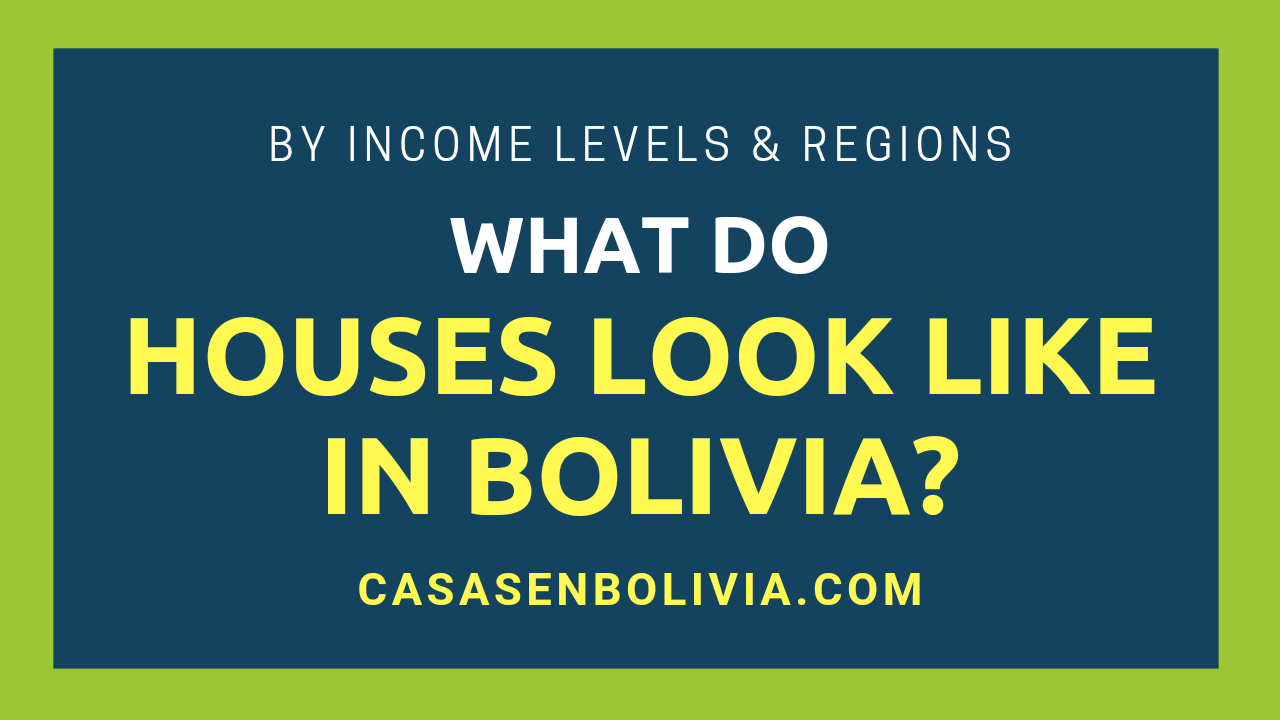Last Updated on February 15, 2025
Bolivian houses generally resemble those in countries like Ecuador, Peru, Mexico, Colombia, and Paraguay. As a developing nation, Bolivia’s homes are often basic, frequently lacking finished work, and in some cases, even lacking basic utilities. However, there are exceptions, particularly with houses in the Altiplano region.
Houses in Bolivia are commonly orange and brown due to the exposed brickwork and lack of finishing. They are often built close together, without visible gardens or parking. In warmer regions, houses again tend to be orange, but also white, surrounded by lush gardens and enclosed by brick walls, wooden fences, or steel mesh.
Here, we’ll show you the general appearance of homes and real estate in Bolivia, considering different income levels and various locations, including urban, rural, and tourist areas.
The General Appearance and Quality of Houses in Bolivia
Houses and real estate in Bolivia typically appear more basic than in developed countries. They are smaller, and exterior paint colors are generally limited to orange, brown, white, and green. Additionally, in 95% of cases, they are surrounded by some type of wall, preventing outside visibility of the building itself.
House appearance also varies significantly based on location:
- In cities in the Altiplano, such as La Paz, El Alto, Oruro, and Potosí, homes are predominantly orange, resembling orange brick cubes with windows, lacking gardens, and usually multi-storied. Many houses are also constructed with adobe bricks and appear brown.
- In cities in the temperate region of the country, like Cochabamba, Sucre, and Tarija, houses are typically situated at the center of the land lot, surrounded by a garden and a brick wall. They are often orange, but many are painted in different colors, most commonly white.
- In cities in the tropical region, such as Santa Cruz, Trinidad, and Cobija, houses are usually positioned at the center of the land lot, but surrounded by dense gardens and trees, as well as by fences made of wood or steel mesh. They often exhibit a mix of white, orange, and green, or a combination of orange, gray, and green.
This describes the average appearance of homes in Bolivia, *but their appearance can also vary significantly depending on the owners’ income*, as we’ll demonstrate below.
How House Appearance Varies by Social Status in Bolivia
Homes and properties, in general, differ significantly in appearance based on the income status of their owners. From small shelters made of adobe or wood to first-world-style standalone houses and apartment high-rises, you’ll find the entire spectrum in Bolivia.
1) Low-Income Housing
Homes belonging to low-income individuals in Bolivia typically appear very rustic and basic, lacking proper maintenance. These houses are usually designed solely by the construction workers, without the involvement of construction companies or architects.
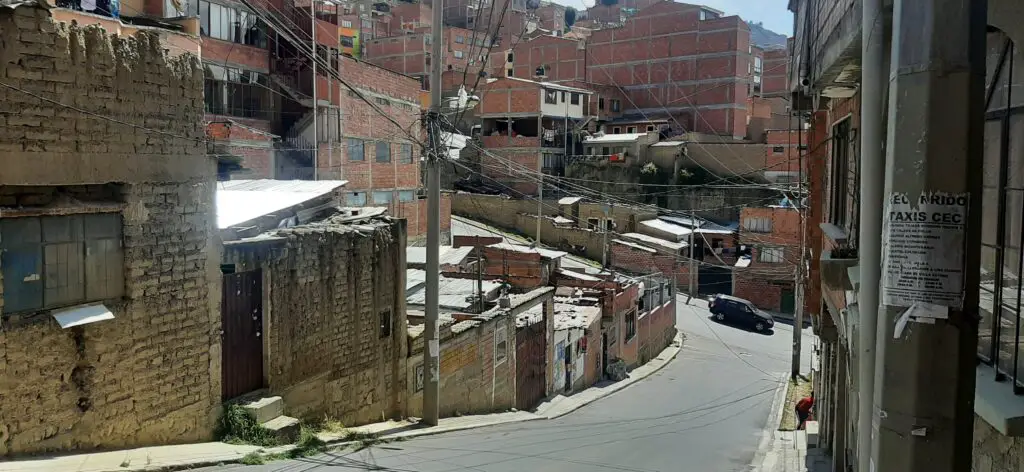
Low-income housing is typically located on the outskirts of cities, within less secure neighborhoods, or in rural areas. These homes *often lack even basic utilities*. Some residents need to go outside to use the bathroom, cook, or wash clothes.
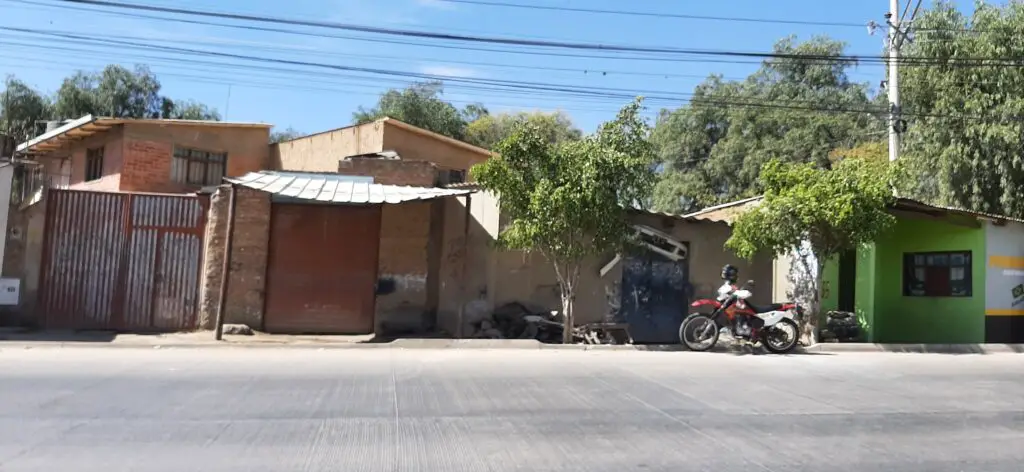
Additionally, these homes often lack a well-defined layout. The bedroom might be combined with the kitchen, there might be no living room, etc. If a garden exists, it’s usually unmaintained and left in a wild state.
Rural houses are typically constructed with rustic materials like “adobe” (a construction block *made of mud mixed with straw*) in the Altiplano and with wood, corrugated metal sheeting, and tarps in tropical regions. In semi-rural areas, these same materials are frequently used.
2) Middle-Class Housing
Homes belonging to middle-class individuals are considerably more robust. They are built with better materials like bricks, cement, and stucco, but they still generally lack a sophisticated design. They are also typically designed solely by the construction workers, with construction companies usually not involved in the design or building process.
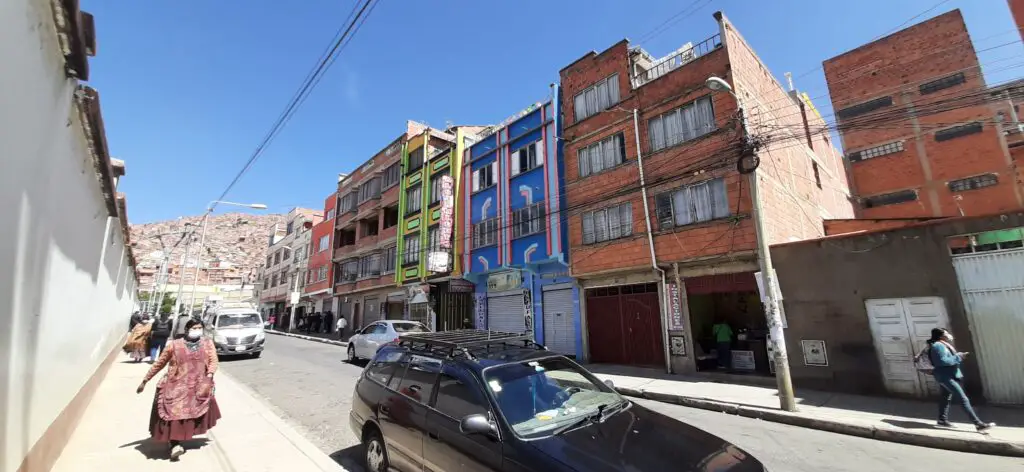
These somewhat better homes often lack finishing work, such as painting and plastering. Many people begin living in them without these processes being completed. *This is why you’ll see many orange, cube-shaped houses* in La Paz, Cochabamba, and even Santa Cruz cities (reflecting the color of the bricks), as these houses haven’t had finishing work done.
Furthermore, these houses typically lack a well-thought-out interior layout. While they have a better distribution than low-income homes, they often lack spacious kitchens or comfortable living rooms. They also tend to lack proper maintenance. However, they usually have all basic utilities adequately provided.
These homes are the most common in Bolivia. Most belong to lower- to middle-income individuals, who constitute the largest segment of the population (more than 60%). In general, these houses are safe to live in, but they don’t have an aesthetically pleasing appearance, offer only basic services, and provide a merely acceptable quality of living.
3) Upper-Class Housing
Homes belonging to the upper class finally offer a good quality of life and feature personalized designs that cater to the specific needs and preferences of the owner. They almost always have finished work completed and have been designed by a certified architect or a construction firm.
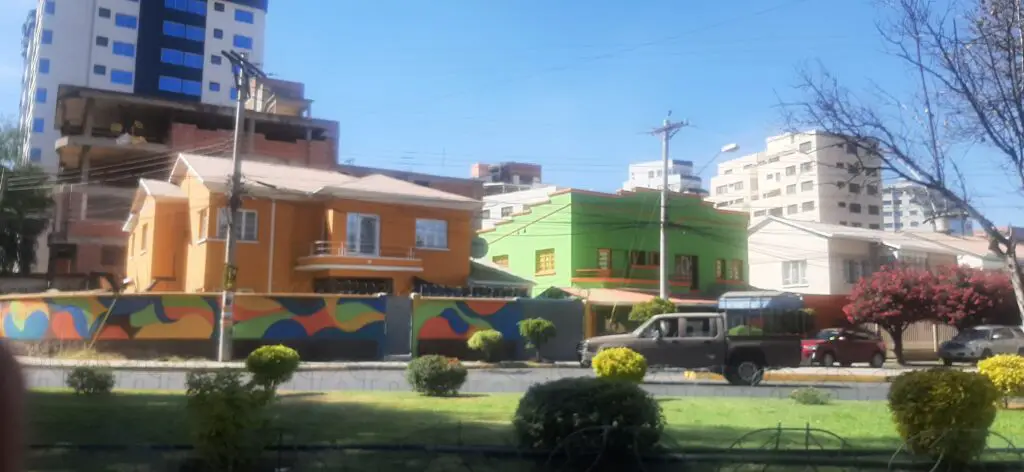
These homes also have an attractive exterior appearance and spacious, well-distributed rooms, incorporating all necessary safety measures and precautions. Many of these properties are within apartment blocks and 4- to 6-story buildings in the downtown areas of major Bolivian cities. In other cases, they are standalone homes in affluent neighborhoods across the country.
We can say that these homes offer a similar quality of living to homes *belonging to middle-income individuals in developed countries*. Therefore, they have all basic services well-covered, are comfortable, and have an aesthetically pleasing appearance both inside and out. However, they don’t offer any particular luxuries. They may appear luxurious to Bolivians, but not to individuals from developed countries, who would likely consider these houses average and ordinary.
Although you can find these houses primarily in premium and affluent neighborhoods of Bolivia, some are located in commercial areas with numerous stores of various types, as well as in the downtown areas of the principal cities. They are rarely found on the outskirts of cities or in rural areas, and they are almost never present in low-income neighborhoods.
4) Homes of Wealthy Individuals
Homes belonging to wealthy Bolivians are a different story. *These properties are exclusively located* in the most premium and expensive neighborhoods link of Bolivia, for example:
- La Paz
- Calacoto
- San Miguel
- Obrajes
- Miraflores
- Sopocachi
- Cochabamba
- Cala Cala
- Queru Queru
- Tiquipaya
- Santa Cruz
- Equipetrol
- Urubo
- Las Palmas
- Urbari
These homes appear luxurious, *even to individuals from developed countries*, and they resemble the homes of upper-class citizens in developed nations. They have all the amenities found in premium houses in countries like the US or European nations, with several bathrooms, large interior spaces, expensive materials in their finishes, etc.
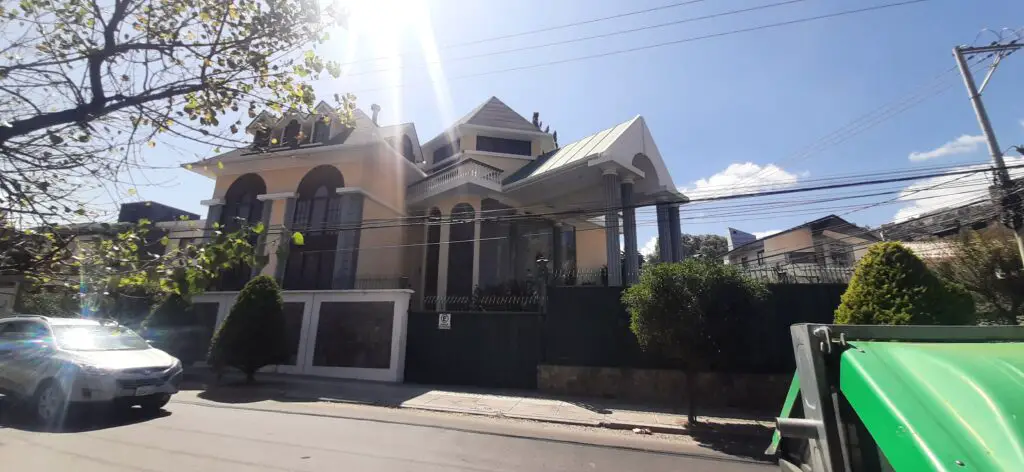
These houses feature, for example, unconventional shapes that reflect the latest trends in home design. They have well-maintained gardens, multiple garages, large gateways, extensive security measures, beautiful landscaping, suites, balconies, pools, and materials like marble, exclusive woods, etc.
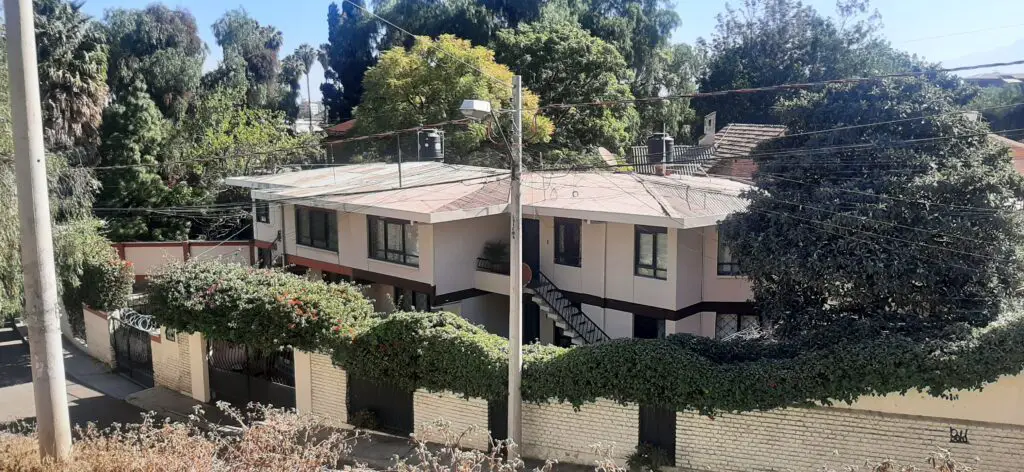
Inside, they have air conditioning, fireplaces, large bathrooms with advanced bathtubs, complex lighting systems, smart home devices, and other amenities. In fact, they closely resemble premium houses in developed countries. However, they don’t resemble the homes of *the wealthiest* individuals in developed countries; that level of luxury is almost non-existent in Bolivia.
The Appearance of Houses Based on Their Location in Bolivia
Now, let’s examine how Bolivian houses appear based on their location within the country.
A) Homes in Cold Cities Like La Paz and Oruro
Most houses in these cities, situated at a very high elevation above sea level, often appear very orange, *like large, cubic orange boxes made of countless bricks*. This is because, as mentioned earlier, most people in Bolivia tend to live in houses that lack finishing work, with basic designs created by construction workers.
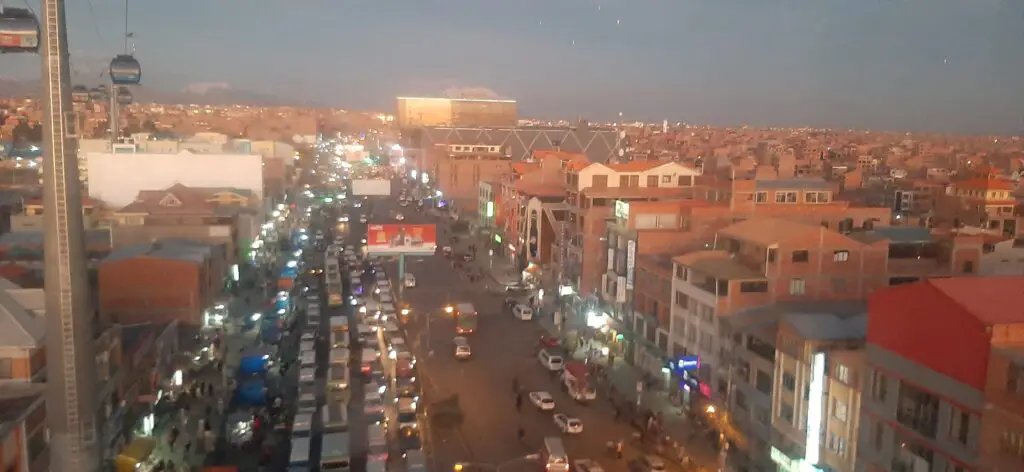
Additionally, these houses typically lack visible gardens. They occupy the entire land on which they’re built and usually have multiple stories, from three to five. Each story contains one or two apartments. Houses resemble boxes of bricks because, as mentioned, they are generally not designed by architects or construction firms, but rather by the construction workers who build them.
In cities located in the Bolivian Altiplano, such as:
- La Paz
- El Alto
- Oruro
- Potosí
There isn’t much space to build houses, so people typically utilize all available land and tend to construct multi-story buildings that lack finishing work. Therefore, they appear, as we described, like “multi-story orange boxes of bricks with windows.”
Additionally, in these cities, the outskirts and nearby rural areas contain houses belonging to lower-income individuals, mostly resembling small adobe houses with a gray to brown color.
However, homes belonging to wealthy individuals look very similar to those found in developed countries, *except in El Alto City*, where affluent individuals can create indigenous designs for their properties, like those shown in the image below.
[Image: wealthy homes in El Alto]
B) Homes in Temperate Cities Like Cochabamba and Sucre
These cities have more favorable climates and are not as cold as those in the Altiplano. Therefore, there’s significantly more space available on larger land lots, where built houses don’t need to occupy the entire space.
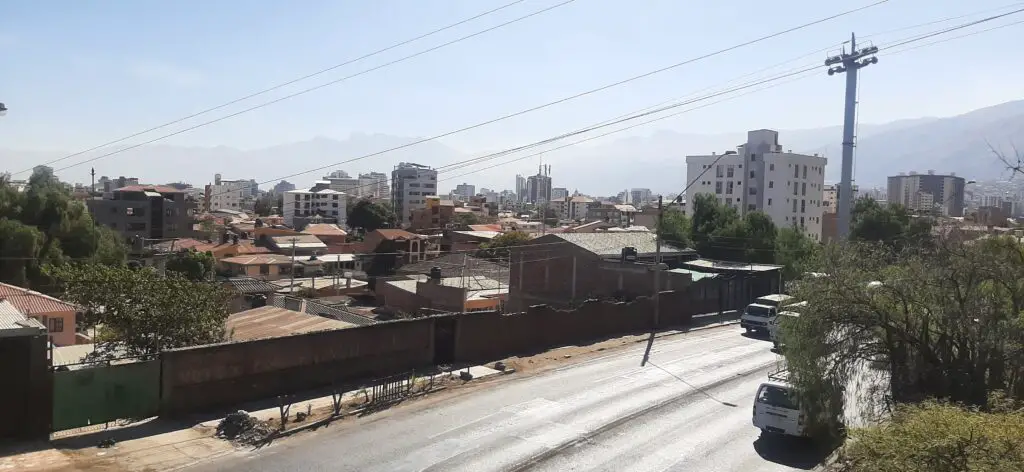
Therefore, homes located in cities in Bolivia’s temperate region, such as:
- Cochabamba
- Sucre
- Tarija
Tend to appear as standalone rustic and rural homes, but considerably less expensive and more basic. These properties often have a central family home with surrounding gardens. However, in all cases, a brick wall or a wooden fence encloses the property. These homes often lack a well-defined interior layout, with small bedrooms, sometimes lacking living rooms, and bathrooms in unconventional locations.
However, if you visit Sucre, you’ll find that *most houses are white*. This is why Sucre is called the “white city” (Ciudad Blanca). Homes there appear to be straight out of a storybook, and they convey a calm and relaxing atmosphere to the city’s inhabitants. That’s also why this city is called the “garden city.” But not everything is perfect; the Chagas disease is also present there, *which is very harmful and deadly*.
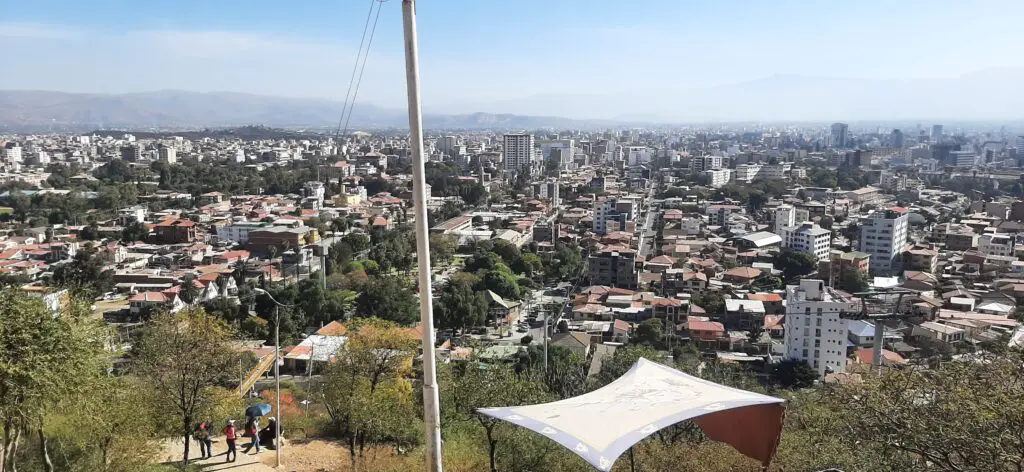
In Bolivia’s temperate region, rural houses are also constructed from rustic materials, like adobe or wood. They typically have natural gardens surrounding them, as well as very rustic fences that separate the house from the surroundings. On the other hand, homes belonging to wealthy individuals in this region are often standalone homes that resemble houses in developed countries. There are also luxury apartments located in the downtown areas or the best neighborhoods.
C) Homes in Tropical Cities Like Santa Cruz
Homes in tropical cities look very different from homes in the Altiplano region and the temperate regions of the country. In these vast tropical lands, there’s ample space for construction, and there’s also significant heat, as the weather is very hot. All of this results in properties *appearing like large gardens with a small house in the center*.
Homes in the country’s tropical region (which accounts for approximately 40% of the total territory) and in tropical cities like:
- Santa Cruz de la Sierra
- Trinidad
- Cobija
Usually are standalone houses surrounded by natural gardens that are often not well-maintained, as well as enclosed by wood fences or steel mesh fences. These homes, which generally belong to lower- to middle-class individuals, are often not well-painted and lack finishing work. Therefore, they frequently appear as a mixture of orange, white, and green (from the bricks and stucco inside, and the dense vegetation outside).
Homes belonging to lower-income individuals in Bolivia’s tropical cities, usually on the outskirts of the city, are even constructed with just wood, tarps, and stainless steel or corrugated metal, surrounded by rustic fences, and often lacking most basic utilities. However, Santa Cruz is also home to Bolivia’s wealthiest individuals, with homes that are quite luxurious and resemble standalone homes in upper-class residential neighborhoods in the US or Canada.
D) Homes in Metropolitan Downtown Areas
Homes located in the downtown areas of Bolivia’s main cities often appear very antique and *feature designs reminiscent of the Spanish colonial era*. Most of these houses have been properly restored and have a high value when sold. However, many others appear abandoned and even dangerous.
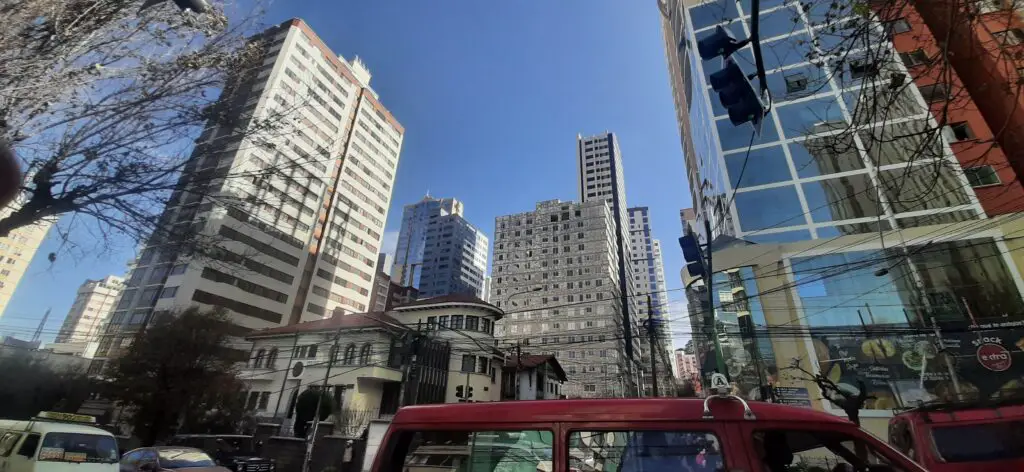
These colonial homes create a contrast with the numerous modern high-rises that are typically located nearby. These skyscrapers are often apartment blocks, but also spaces for corporations and businesses. This results in a mix of colonial houses and cutting-edge high-rises, which is commonly seen in the downtown areas of large Bolivian cities.
In other, newer cities founded after Bolivia’s independence, like El Alto city, you’ll find that they typically have many multi-story buildings with apartments, offices, and commercial spaces, along with high-rises in the downtown areas. Endless 4- to 6-story buildings, along with some skyscrapers, can be seen in these newer urban areas.
E) Homes on the Outskirts of Cities
Houses primarily belonging to lower-income individuals will be present on the outskirts of cities, so they will appear modest and small. In many cases, they will lack proper maintenance, be constructed with less durable materials like adobe and wood, or lack finishing work. They very often lack basic utilities, but they are usually surrounded by brick walls, steel mesh, or wooden fences.
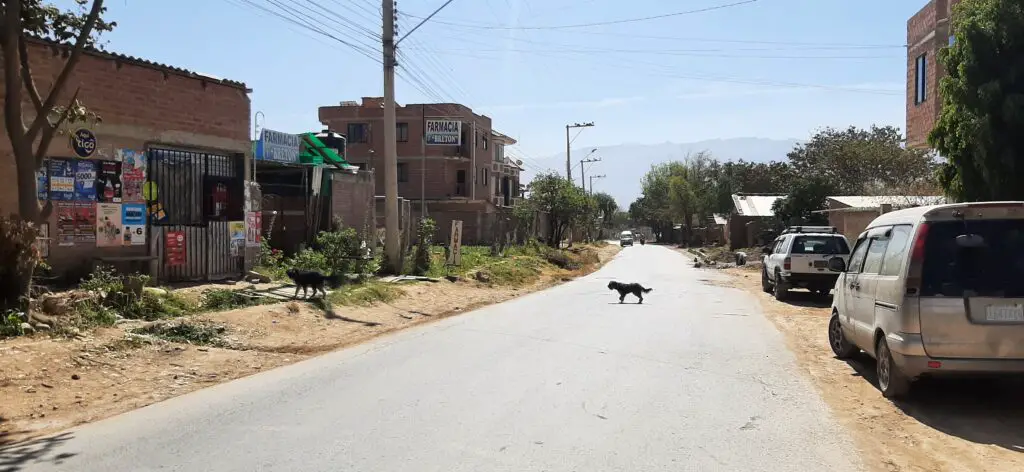
However, in some cases, affluent individuals reside in certain neighborhoods near rural areas, and these homes have the appearance of vacation homes, with all the necessary amenities for a comfortable retreat. This is commonly observed in neighborhoods like:
- Valencia in La Paz
- Tiquipaya in Cochabamba
- Urubo in Santa Cruz
In these affluent neighborhoods on the outskirts of these cities, vacation and retreat homes often appear very luxurious.
F) Homes in Rural Areas
In rural areas, far from cities and larger towns, people typically live in homes made of adobe in both the Altiplano and temperate regions, but constructed with wood and bricks in rural tropical regions. These homes are often surrounded by fields and pastures, as well as livestock.
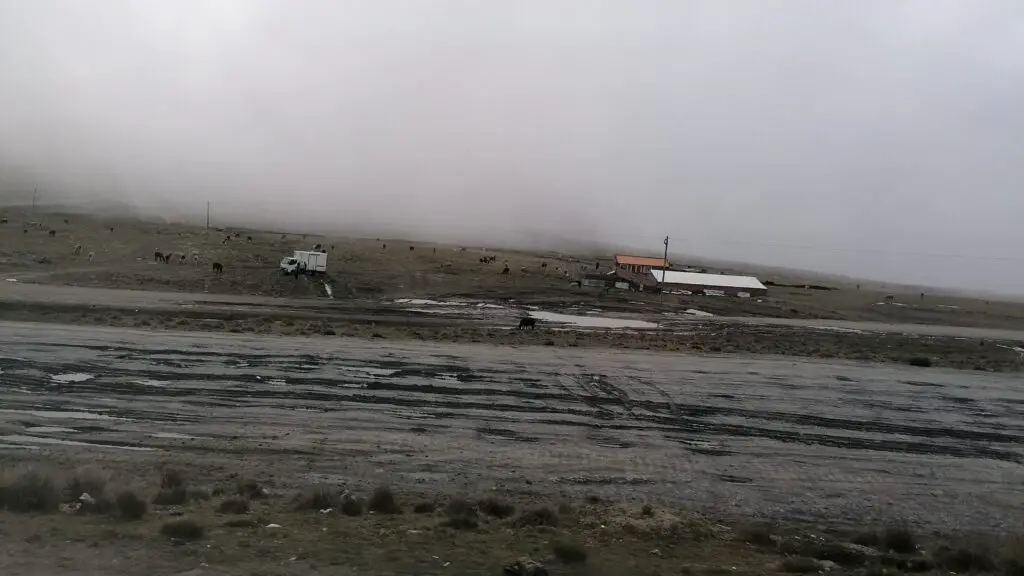
It’s common to see small towns with fewer than 1,000 residents when visiting rural areas in Bolivia. In these towns, small, standalone houses for individual families are typically situated close together around a central main square. These towns generally don’t exceed 400 to 600 meters (approximately 1,300 to 2,000 feet) in diameter.
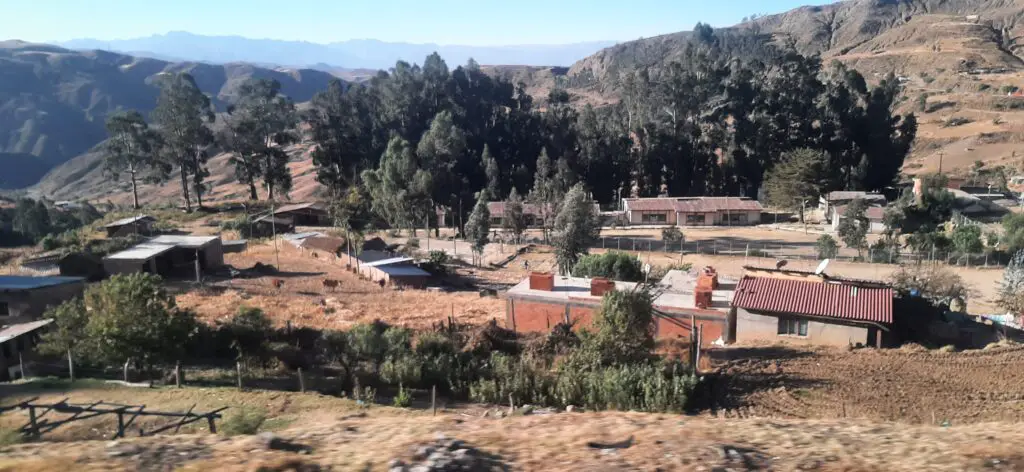
In the Altiplano, most rural homes are constructed with orange bricks or adobe (some are painted), giving towns a mix of orange and brown hues. In tropical regions, rural homes in small towns are typically built with smaller orange bricks, wood, and stucco, surrounded by dense vegetation, resulting in a predominantly green appearance, mixed with white, orange, and brown.
G) Homes in Tourist Locations
Homes located within tourist destinations in Bolivia often have a distinct appearance compared to other homes. This is primarily because they are located in:
- Very old areas of cities, exhibiting architectural styles from the colonial era, such as Jaen Street in La Paz, where very antique, yet well-maintained, homes are present.
- Unique locations like the Uyuni Salt Flat, where some houses and hotels are even constructed from salt.
- Remote towns or National Parks, like Rurrenabaque or Eduardo Avaroa National Park, where there are no conventional homes, only shelters or very rustic dwellings.
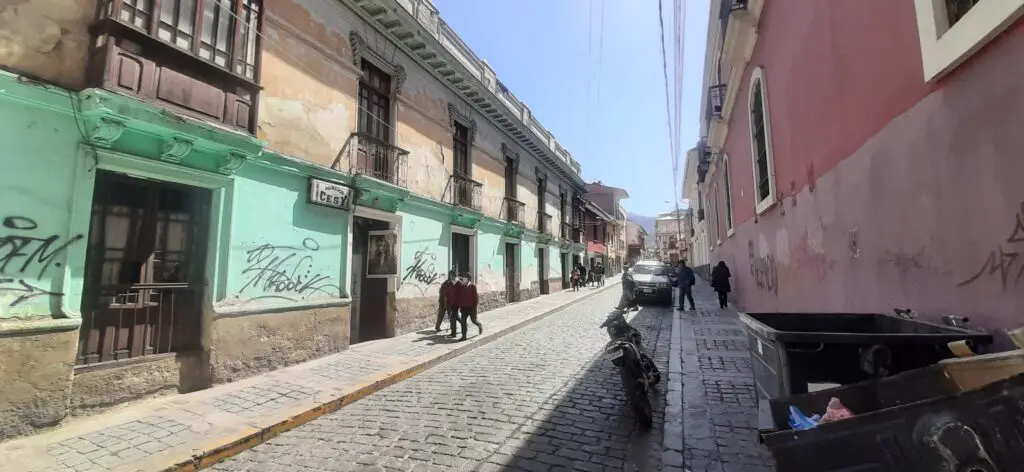
In general, tourist destinations adapt their appearance to be more appealing to visitors and to align with the main attractions of those locations.
Neighborhoods in Bolivia Have a Very Different Design Than in Developed Countries
The urban layout in Bolivia differs significantly from that of the US and Canada. It more closely resembles European cities, with most activities concentrated around the central and downtown areas.
In the US and Canada, residential areas are distinctly separated from commercial and industrial zones. There’s a designated place for living, another for working, and another for production. In contrast, *in Bolivia, you’ll find that people often live where they work, and in many cases, where they produce*.
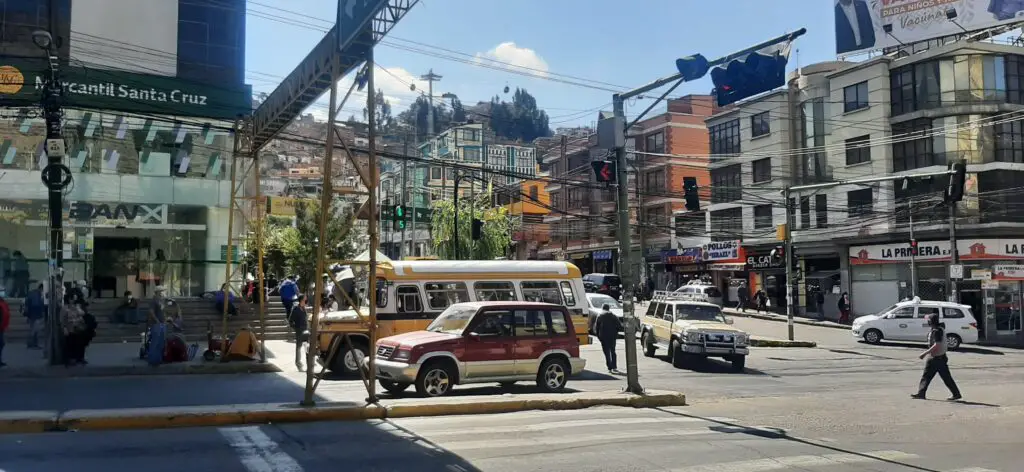
There’s no clear zoning distinction between residential, commercial, and industrial areas anywhere in Bolivia. Consequently, most streets are a mix of businesses, various types of stores, and homes. Between these properties, you’ll also find multi-story skyscrapers. In downtown areas, you’ll encounter extremely crowded avenues and streets with large open-air markets, homes, and businesses of all sizes, along with a generally chaotic atmosphere.
Downtown areas in Bolivian urban centers often resemble European cities, but they are generally less affluent and less organized. Everything is mixed: residential, commercial, and even industrial areas.
Conclusions:
In this overview of the appearance of houses and real estate in Bolivia, you’ve seen that major cities are generally arranged similarly to European cities but appear more basic and less affluent. Urban areas in Bolivia typically combine residential spaces with both commercial and industrial activities.










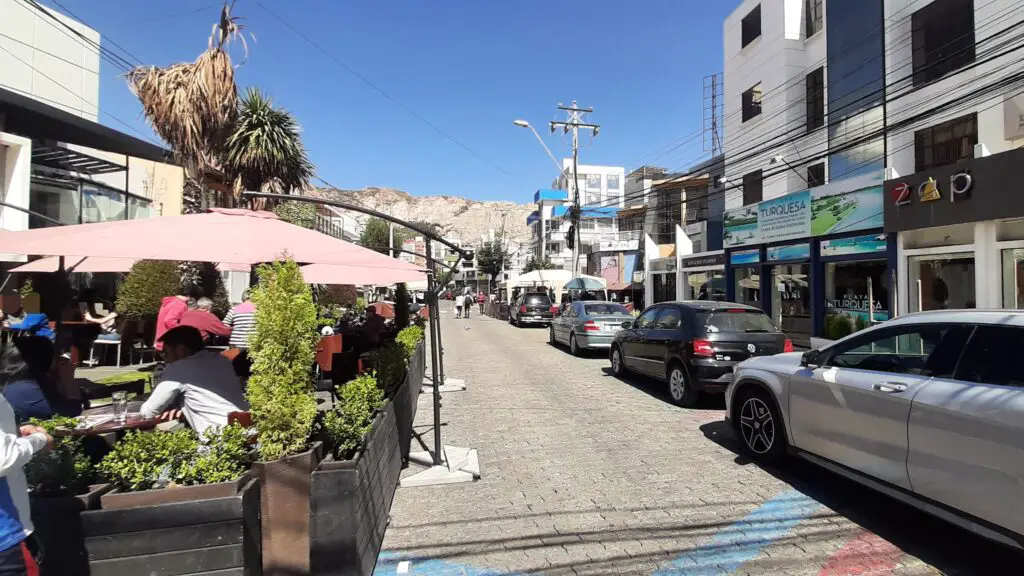
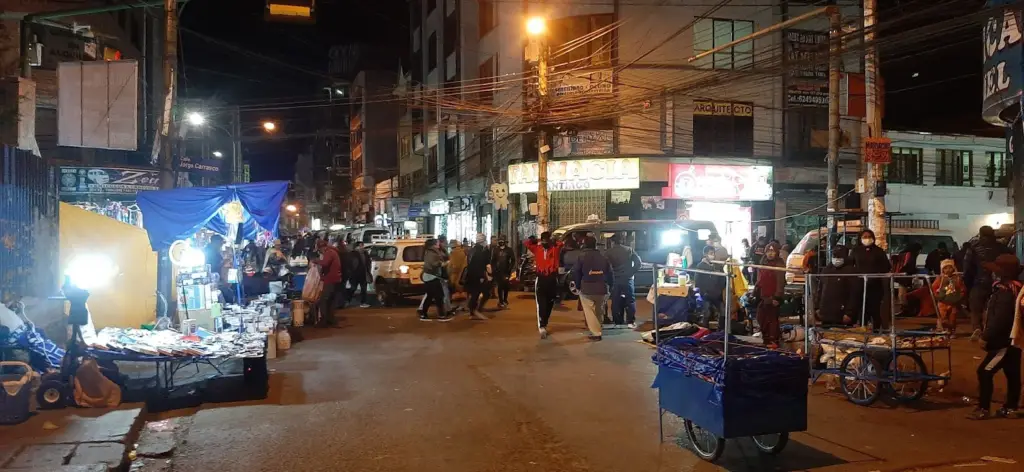
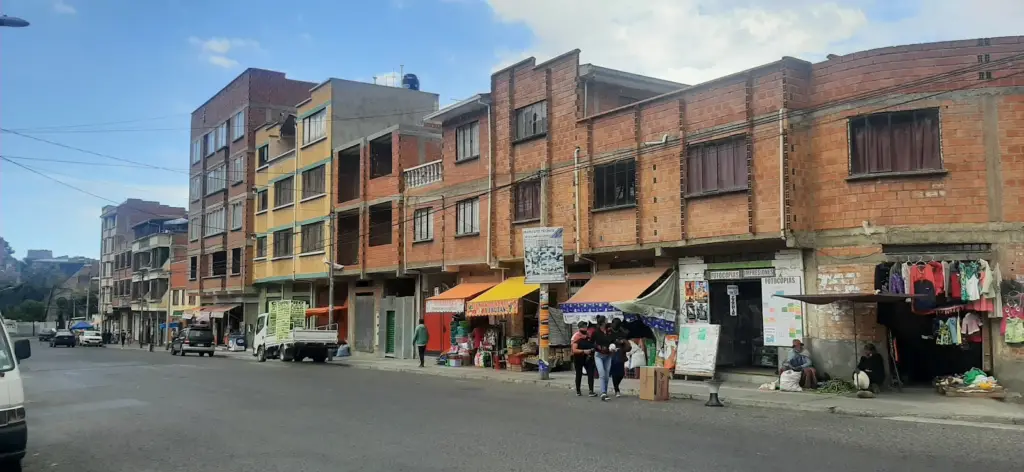

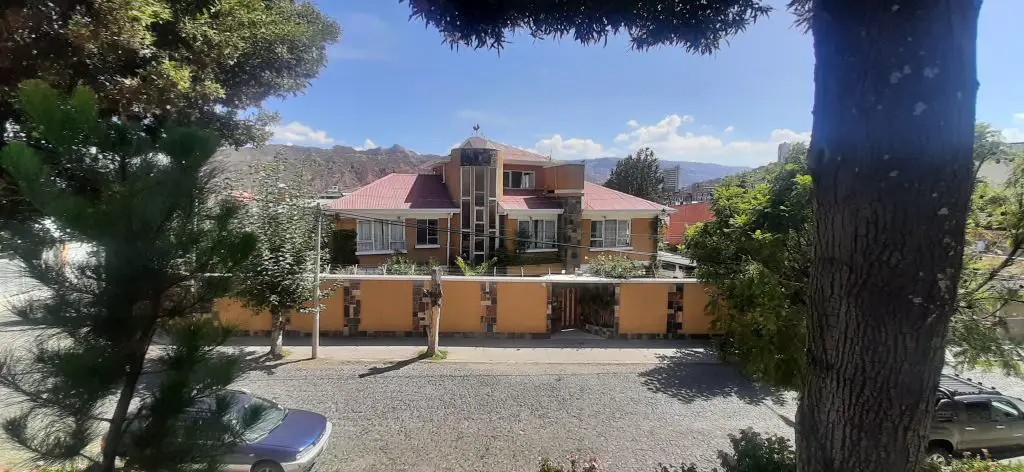
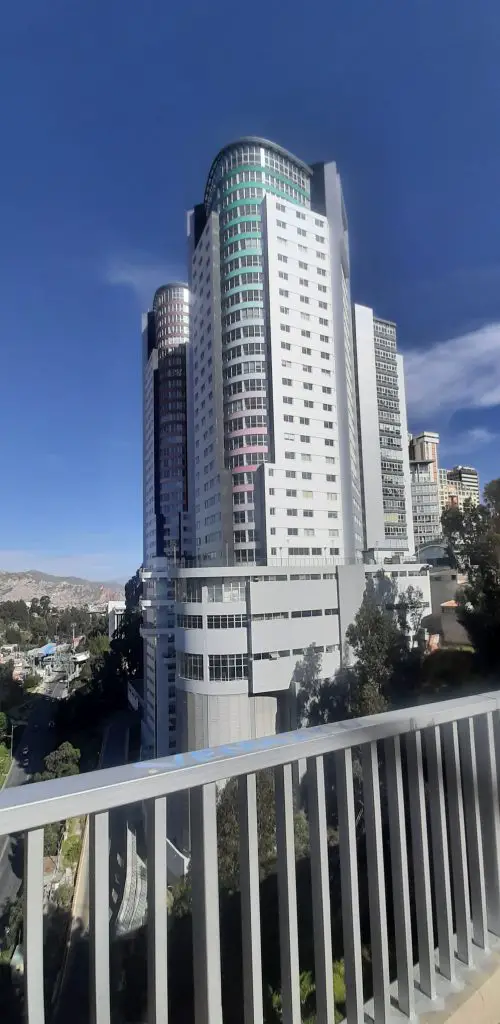
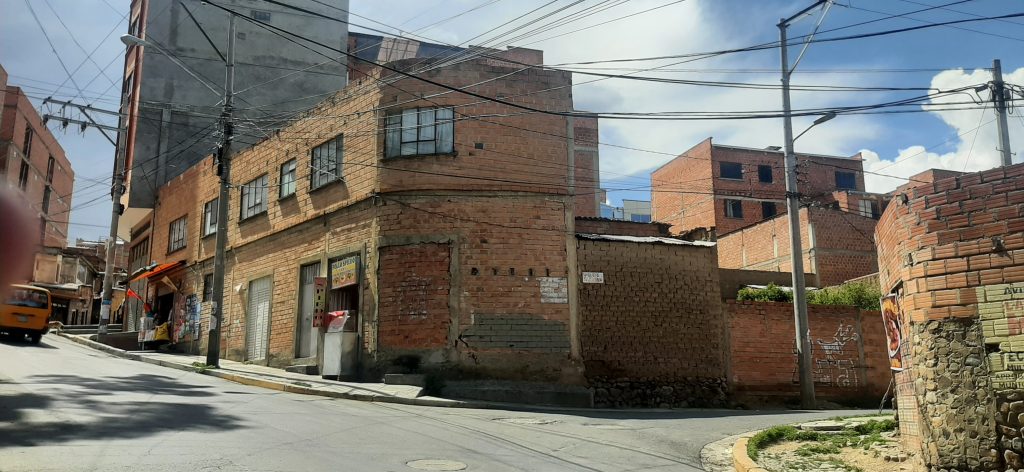
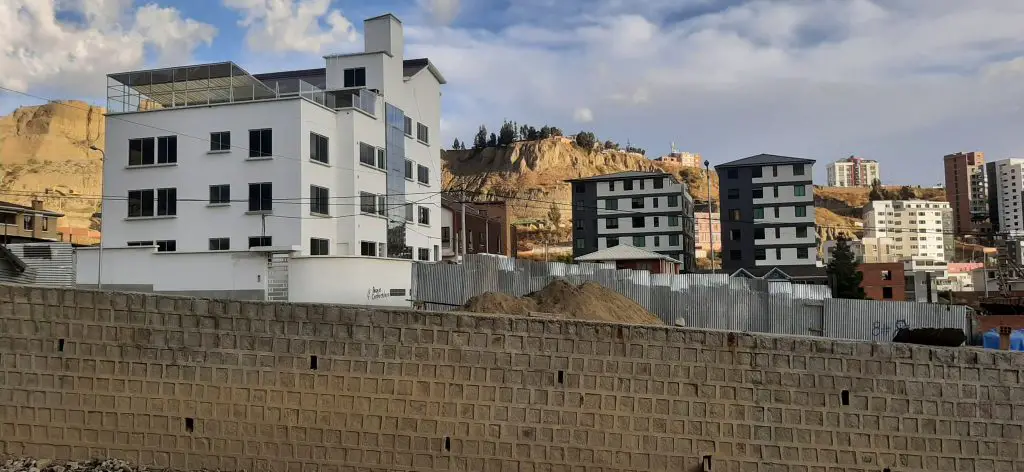
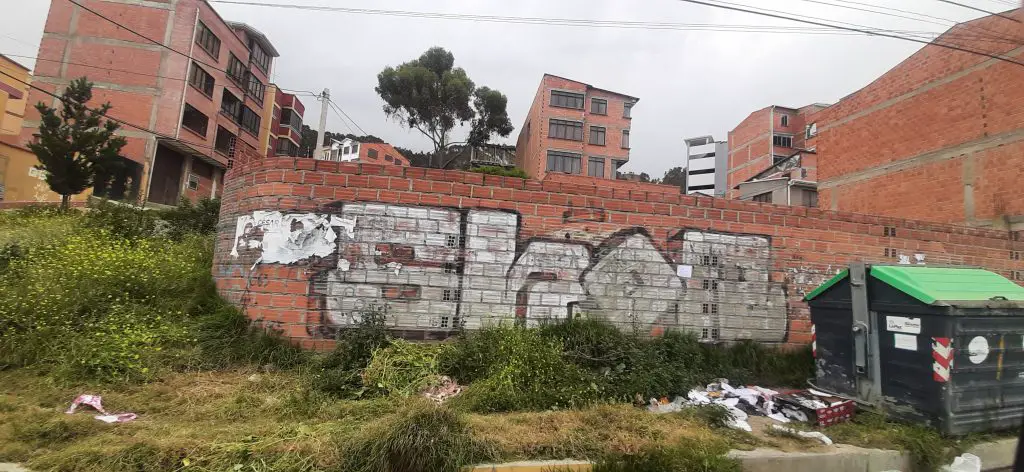
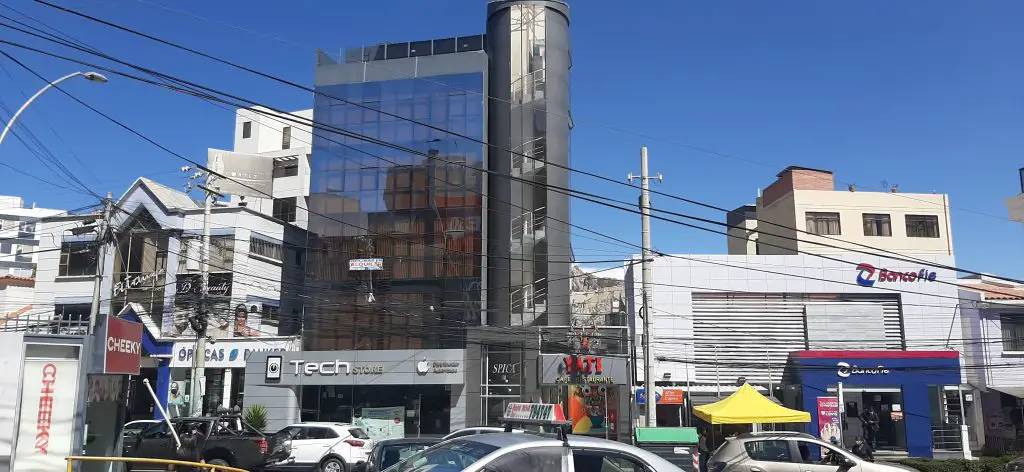





You also learned that, in general, homes look orange in Altiplanic regions, without any garden or parking lot visible (cars usually park in the street, and there are big gateways that get opened for cars in these houses). In contrast, you’ve seen that in tropical places houses appear to be central small homes surrounded by bushy gardens as well as walls of orange bricks or wood fences.
You also saw that homes from poor people are usually built with adobe bricks or wood and they look very rustic, brown or gray, small, and without even basic services. On the other hand, you’ve realized that houses in wealthy neighborhoods look like residential homes in North America and Europe, they even seem to be from upper-class people of these regions and countries.
We hope this information has helped you, and if you want to know how much it really costs to build a house in Bolivia, accounting for all the different types mentioned here, with every detailing number, visit our dedicated guide: How much does it cost to build a house in Bolivia? A full overview.
CasasenBolivia.com, information about how to live, work, invest, and travel in Bolivia.

